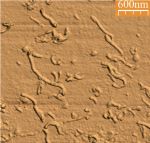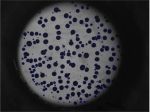EPJ E Highlight - Optimum inertial self-propulsion design for snowman-like nanorobot
- Details
- Published on 22 July 2014

A new study investigates the effects of small but finite inertia on the propulsion of micro and nano-scale swimming machines that could have implications for biomedical applications
Scale plays a major role in locomotion. Swimming microorganisms, such as bacteria and spermatozoa, are subjected to relatively small inertial forces compared to the viscous forces exerted by the surrounding fluid. Such low-level inertia makes self-propulsion a major challenge. Now, scientists have found that the direction of propulsion made possible by such inertia is opposite to that induced by a viscoelastic fluid. These findings have been published in EPJ E by François Nadal from the Alternative Energies and Atomic Energy Commission (CEA), in Le Barp, France, and colleagues. This study could help optimise the design of self-propelled micro- and nanoscale artificial swimming machines to improve their mobility in medical applications.
EPJ E Highlight - Refined biological evolution model
- Details
- Published on 07 July 2014

A new study accounts for species interactions, and adds a layer of complexity to previous minimalists models
Models for the evolution of life are now being developed to try and clarify the long-term dynamics of an evolving system of species. Specifically, a recent model proposed by Petri Kärenlampi from the University of Eastern Finland in Joensuu accounts for species interactions with various degrees of symmetry, connectivity, and species abundance. This is an improvement on previous, simpler models, which apply random fitness levels to species. The findings published in EPJ E demonstrate that the resulting replicator ecosystems do not appear to be a self-organised critical model, unlike the so-called Bak-Sneppen model; a reference in the field. The reasons for this discrepancy are not yet known.
Ludwik Leibler awarded the EPJE Pierre-Gilles De Gennes Lecture Prize for 2014
- Details
- Published on 23 June 2014

The journal EPJE – Soft Matter and Biological Physics is pleased to honour Ludwik Leibler with the 2014 EPJE Pierre-Gilles De Gennes Lecture prize. Leibler is researcher at CNRS and Adjunct Professor at ESPCI ParisTech where he directs the Laboratory for Soft Matter and Chemistry. The Editors of the journal nominated him for his seminal contributions to polymer physics and the revolutionary polymeric materials, self-healing elastomers and vitrimers that he invented. This is the 4th edition of this prestigious prize, named after the Nobel laureate who founded EPJE. The prize consist of 1000 Euros and a plenary lecture that will be introduced by Daan Frenkel, co-Editor-in-Chief of EPJE. The EPJE Pierre-Gilles de Gennes lecture will be delivered July 22nd in Lisbon, during the 9th Liquid Matter conference of the European Physical Society.
EPJ E Highlight - Horizontal levitation: the ultimate solution to particle separation
- Details
- Published on 07 June 2014

Separating particles from the liquid they are in can now be done with a new concept, based on horizontal deflection during particle levitation for the separation of minerals and particles.
Magnetic separators exploit the difference in magnetic properties between minerals, for example when separating magnetite from quartz. But this exercise becomes considerably more complex when the particles are not magnetic. In the wake of previous particle levitation experiments under high-power magnetic fields, a new study reveals that particles are deflected away from the magnet’s round-shaped bore centre in a horizontal direction. Previous studies had observed the vertical levitation of the particles. These findings are presented by Shixiao Liu from the Faculty of Engineering, University of Nottingham, UK and colleagues, in a paper recently published in EPJ E, and could led to a new concept in particles and minerals separation technologies.
EPJ E Highlight - Elucidating optimal biological tissue shape during growth
- Details
- Published on 28 May 2014

A new study investigates the role of cells’ alignment in shaping biological tissue, as cell division provides dynamic evolution during tissue growth.
A team of European scientists has now extended a previous biophysical model to investigate elongated growth within biological tissues to describing the evolution over time of the shape of a fruit fly’s wing. They found the aspect ratio of the typical biological shapes may exhibit a maximum at finite time and then decrease. For sufficiently large tissues, the shape is expected to approach that of a disk or sphere. These findings have been reported by Carles Blanch-Mercader from the University of Barcelona, Spain, and colleagues, in a paper published in EPJ E. They provide a more general classification than previously available of the different types of morphologies a tissue can be expected to attain, depending on its initial size and its physical properties.
EPJ E Highlight - Stability lost as supernovae explode
- Details
- Published on 29 April 2014

A new model accounting for the loss of stability occurring at the very start of supernova explosions sheds some new light on this phenomenon, opening up potential broader applications
Exploding supernovae are a phenomenon that is still not fully understood. The trouble is that the state of nuclear matter in stars cannot be reproduced on Earth. In a recent paper published in EPJ E, Yves Pomeau from the University of Arizona, USA, and his French colleagues from the CNRS provide a new model of supernovae represented as dynamical systems subject to a loss of stability, just before they explode. Because similar stability losses also occur in dynamical systems in nature, this model could be used to predict natural catastrophes before they happen. Previous studies of the creeping of soft solids, earthquakes, and sleep-wake transitions have already confirmed the validity of this approach.
EPJ E - Andreas Bausch, the new biological physics EiC
- Details
- Published on 07 April 2014

This month EPJE welcomes Andreas Bausch, who takes over from Frank Jülicher, as Editor in Chief for biological physics in EPJ E – Soft Matter and Biological Physics. In his lab, Bausch applies new experimental tools of soft condensed matter physics to living cells and bio-mimetic model systems. This is his vision for biological physics within EPJE in the years to come:
EPJ E Highlight - Making the most of carbon nanotube-liquid crystal combos
- Details
- Published on 26 March 2014

A better understanding of the physical response of combination materials made of nanotubes with ferroelectric liquid crystals could soon open the door to applications as sensors or switches
Dispersions of carbon nanotubes with liquid crystals have attracted much interest because they pave the way for creating new materials with added functionalities. Now, a study published in EPJ E by Marina Yakemseva and colleagues at the Nanomaterials Research Institute in Ivanovo, Russia, focuses on the influence of temperature and nanotube concentration on the physical properties of such combined materials. These findings could have implications for optimising these combinations for non-display applications, such as sensors or externally stimulated switches, and novel materials that are responsive to electric, magnetic, mechanical or even optical fields.
EPJ E Topical Review: Foaming experiments on the ISS
- Details
- Published on 24 March 2014

Foams and foaming processes pose interesting questions for both fundamental research and practical applications. Although foams are a familiar thing, both in our everyday lives and in industry, many aspects of foam physics and chemistry still remain unclear.
This EPJ E paper comprehensively reviews the studies of foams under microgravity, including studies conducted in parabolic flights, in sounding rockets and in the International Space Station.
EPJ E Highlight - Towards tailor-made adhesives
- Details
- Published on 24 January 2014

The inner structure of soft adhesive materials during the debonding process is, for the first time, under scrutiny in the hope of producing new, improved adhesives in the future
Tape, self-adhesive labels, Post-it notes and masking tape all contain soft adhesives. This makes them easy to remove—a process referred to as debonding. French scientists have studied how soft adhesives work in the hope of facilitating the design of more efficient adhesives. Francois Tanguy, a researcher at ESPCI ParisTech, the School of Industrial Physics and Chemistry, in Paris, France, and colleagues have, for the first time, performed a precise analysis of the material deformation and structure during the course of debonding for several model adhesives. Their findings are published in EPJ E. By better understanding the connection between the energy dissipated by the polymeric material with adhesive qualities and its response to traction, they hope to improve models of adhesive performance.





